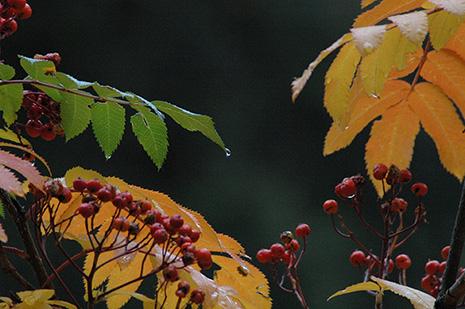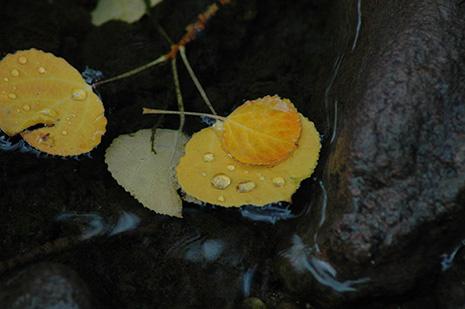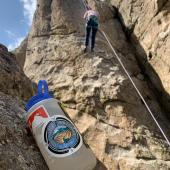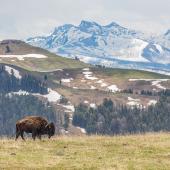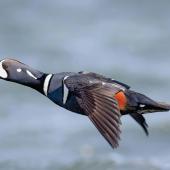The Beauty & Science of Autumn
An outing with the Yellowstone Forever Institute.
The thunder-train raced along on its track of lightning, throwing hail-like bits of white coal from its furnace. Aspen quivered. Chipmunks took cover. The stellar jay chattered and huddled in the branches of the old Doug fir while water washed in beads off its back. All 14 members of our Yellowstone Association class, “Beauty & Science of Autumn,” waited on the bus for the storm to pass. Autumn storms may be short, but they’re also violent—no sense in setting up scopes and cameras to look for mountain goats, just to have our equipment get drenched in this cell of electrified weather.
Small pellets of rain continued to fall while scudding clouds bellied out overhead, until they broke up and the sky cleared. Sun from the west pierced the curtains to draw a triple rainbow across the now-highlighted hills beneath us in the valley. We almost tripped over each other as we hurried to capture the day-glow colors.
We spread out under dripping firs. Under our feet, autumn had spread a Persian carpet woven with hues of every color, from butter-yellow to burgundy, using its box of pigments containing anthocyanins and carotenids. Time, and sliding temperatures signaling the onset of fall, had erased the chlorophyll present from the first tender shoots of spring until late summer.
My eyes strained to focus on the shifting band of colors through my camera lens. All around me, classmates arranged themselves on wet, lichen-splashed rocks or on the carpet of grass now glistening in the sun.
The thunder-train rolled on, carrying its payload of sound and storm, leaving hail-lined roads in its wake. Spreading dogbane licked the sagebrush hillsides and the air was heavy with its pungent scent. The Gardner River, so clear in the morning when we ascended into the Park entrance outside Gardiner, was now thick with silt. Pages in my notebook that had been half-filled in the morning were now brimming with facts about changing seasons in the Greater Yellowstone Ecosystem, and in particular Yellowstone National Park. The sensors in my camera had captured trickling streams, stately elk, a rainbow, and the golden yellow of “quakies.”
We had been to the top of the world where ghosts of rain and wind swirled around us and unbuttoned coats. We had been out in the valley admiring the thickening coats of bison. Autumn had entered my imagination by a circuitous route laced with leaves and needles, caterpillars and chlorophyll, and questions about how some animals become white and others sleep a long time.
Elk rut and mate, bears enter hyperphagia, biological clocks tick toward a time when some living things migrate and others find ways to stick it out. Autumn teems with transition. The atmosphere is alive with energy. When leaves fall, they pattern the ground in abstract designs like paint flung from a brush and then decompose to give life to the tree and plants around it in the understory like mosses or roses or the woolly caterpillar. With a whisper, and then a shout, the roll-call begins for winter.
Three days spent studying the broad canvas of the autumn season in Yellowstone Park with Yellowstone Forever was only an appetizer. Colors and storms left me wanting to know more about the substance of its main course and to spend more time being painted with its brilliant hues and washed by its rain. By allowing it in through my eyes, I felt changed again as I always do when I take the time to have the Park flow into me in its many facets.
For more Yellowstone Forever courses, visit yellowstone.org/experience/yellowstone-forever-institute.



